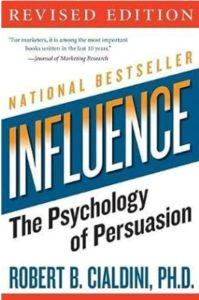Reading Notes For:


Part 2: The Reciprocity Rule.
This is a summary of my reading notes from Influence by Robert Cialdini.
“Influence: The Psychology of Persuasion” by Robert Cialdini is a timeless masterpiece that unveils the secrets of persuasion. Cialdini delves into human psychology, revealing six principles of influence that guide our decisions. What sets this book apart is its practicality; it offers actionable strategies for marketing, sales, and communication. Cialdini’s storytelling prowess makes the concepts engaging and memorable. It remains relevant despite its 1984 publication, offering a solid foundation for understanding human behavior in a changing world. Importantly, “Influence” emphasizes ethical persuasion, making it a must-read for anyone seeking to influence others with integrity.
Ladies and gentlemen, as we delve deeper into the intricate world of reciprocation, I have some remarkable insights to share with you. We’ll not only explore the rejection-then-retreat technique but also uncover its applications in door-to-door sales operations, the psychology behind it, and how to effectively navigate these complex dynamics. So, get ready for a detailed journey into the fascinating realm of reciprocity.
In my extensive investigations of door-to-door sales operations, I’ve had the opportunity to witness a less engineered but equally effective version of the rejection-then-retreat technique. These sales organizations have their priorities straight – their primary objective is, of course, to close the sale, but they also emphasize the critical importance of acquiring referrals from prospects. These referrals, which include names of friends, relatives, or neighbors, are like gold because they significantly boost the chances of making a successful sale. Why? Well, let’s peel back the layers and examine this strategy in depth.
We’ve previously discussed how the rejection-then-retreat technique incorporates the reciprocity rule to its advantage. But its effectiveness can be attributed to not just reciprocity but also two other key factors. The first factor involves the perceptual contrast principle, which we encountered earlier. Picture this: if I want you to lend me five dollars, I can make it seem like a smaller request by initially asking for ten dollars. By later retreating to the smaller sum of five dollars, I not only harness the power of the reciprocity rule but also create a perceptual contrast that makes the request appear more reasonable. When these two influences, reciprocity and perceptual contrast, converge within the rejection-then-retreat sequence, they generate a formidable force that can yield astonishing results.
Now, you might be wondering whether there’s a downside to this technique. Will individuals who fall for it resent being manipulated into compliance? Will they experience regret later? Surprisingly, research suggests that these negative reactions occur less frequently than you might expect.
In a revealing study conducted in Canada, researchers set out to investigate whether individuals who fell prey to the rejection-then-retreat tactic would follow through with their agreements. Participants were asked to volunteer for two hours of unpaid work at a community mental-health agency. However, before making this request, researchers first presented a more significant ask – to commit to being a counselor to a juvenile delinquent for a two-year period. As anticipated, a larger number of people agreed to the smaller request after the initial, more substantial request was rejected. Here’s where it gets intriguing – those who volunteered after experiencing the rejection-then-retreat procedure not only agreed but were also significantly more likely to show up and fulfill their commitments as promised. It’s as though this tactic not only prompts agreement but also fosters a sense of responsibility and even motivates individuals to volunteer for additional requests.
But our journey doesn’t end there. It’s crucial to understand that the requester who employs the reciprocation rule, or any other weapon of influence, to gain our compliance isn’t the true opponent. The genuine adversary is the rule itself. To protect ourselves from manipulation, we must learn to defuse its power.
The critical question is: how can we neutralize the impact of a social rule as potent as the one for reciprocation? Imagine you find yourself in a situation where someone offers you something with the ulterior motive of selling you a costly alarm system. Your most effective course of action lies in a straightforward yet powerful maneuver – a private mental redefinition. Instead of viewing whatever you’ve received from the person as gifts, consider them as sales devices. This mental shift liberates you to either decline or accept their purchase offer without feeling ensnared by the reciprocity rule.
And even if they attempt to retreat and seek referrals from you, you can employ the same mental maneuver. Interpret their retreat for what it genuinely represents – a strategic compliance tactic. By grasping these techniques and being cognizant of the intricate psychological forces at play, you can traverse the compliance battlefield with resilience and wisdom, emerging unscathed and possibly even better off than before.
So, there you have it – a comprehensive exploration of the rejection-then-retreat technique, its nuances, and strategies to safeguard yourself from its influence. It’s all about mastering the art of reciprocity and wielding it with precision. Thank you for accompanying me on this detailed journey, and remember, knowledge is your greatest ally in the realm of influence.
